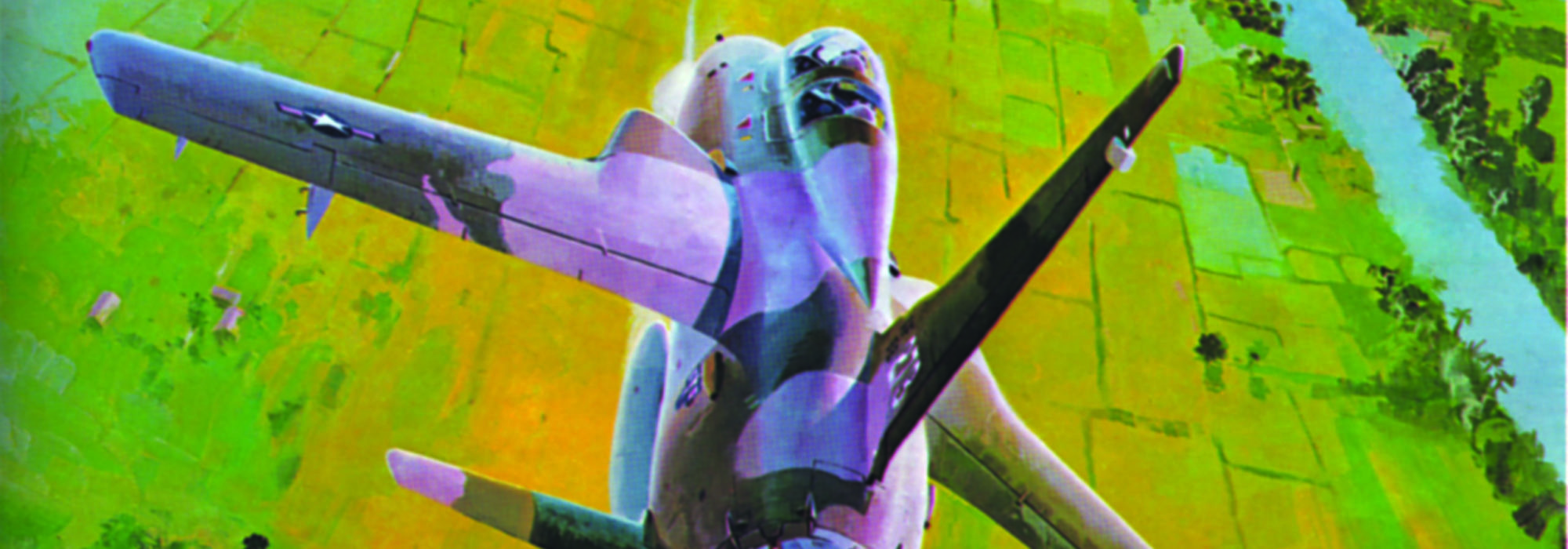–
The Soviet SA-2 surface-to-air missile was already well known to US intelligence when the Vietnam War began. It had brought down Francis Gary Powers in a CIA U-2 spyplane over the Soviet Union in 1960 and an Air Force U-2 during the Cuban missile crisis in 1962. The SA-2 had a range of about 25 miles and accelerated to Mach 3.5 as it closed on the target. It was deadly against aircraft at medium and high altitudes. Its NATO code name was Guideline, but to the airmen who faced it in Southeast Asia, it was simply “the SAM,” or sometimes “Sam.”
The first SAM sites in North Vietnam were detected in April 1965. US military commanders wanted to destroy them right away, but Secretary of Defense Robert S. McNamara refused permission, fearing that Soviet technicians might be killed and the conflict would escalate. John T. McNaughton, assistant secretary of defense for international security affairs, ridiculed the need to strike the SAMs. “You don’t think the North Vietnamese are going to use them!” he scoffed. “Putting them in is just a political ploy by the Russians to appease Hanoi.”
McNaughton’s surmise was soon discredited. On July 24, 1965, an SA-2 shot down an Air Force F-4C, the first of 110 USAF aircraft lost to SAMs in Southeast Asia. The White House approved a retaliatory air strike, but by the time it got there, the SAM batteries were long gone. Instead, dummy missiles had been placed at the site as a “flak trap.” The attacking aircraft were lured within range of concealed air defense guns, which shot down four of them.
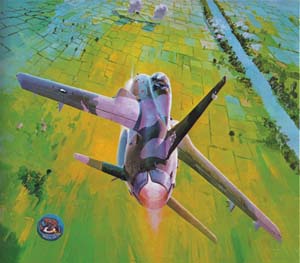 |
Wild Weasel painting by Keith Ferris. |
In August, US Pacific Command set up an operation called “Iron Hand,” in which Air Force and Navy aircraft would try to destroy or defeat the SAMs. However, Iron Hand did not yet have the necessary tools, which were developed through a rush Air Force project named “Wild Weasel.” Two-seat F-100F fighters were outfitted with radar homing and warning (RHAW) gear to detect emissions from the SAM’s fire control radar. The F-100F was armed with a 20 mm cannon and rockets to mark or attack the target. Navigator/electronic warfare officers were recruited from Strategic Air Command to fly in the backseats and operate the special equipment.
A Classic Combination
In November, the first Weasels reported to the 388th Tactical Fighter Wing at Korat AB, Thailand, where they teamed up with F-105D fighter-bombers for Iron Hand missions, and began flying missions in December. The Weasels found and marked the SAM sites, and the F-105s attacked them with missiles and bombs. It worked reasonably well. The Weasels flew as escorts with F-105D strike flights, and when in SAM territory, they moved out in front. The main problem was that the F-100, flying at 400 knots, was too slow. The F-105s, coming along behind at their preferred speed of 500 knots, had to weave to keep from overtaking the Weasels.
The obvious solution was to use the fast and sturdy F-105—known to all as the “Thud”—as the Wild Weasel aircraft. A number of two-seat F-105F trainers were promptly modified for Weasel duty. Like the F-100s, they had 20 mm cannons, but instead of target-marking rockets, they carried Shrike missiles, which homed on the SAM’s radar signals.
This was the classic Wild Weasel combination, replacing the F-100Fs, which flew their last missions in July 1966. The first 11 of the F-105 Weasel aircraft arrived at Korat in May 1966, and another seven deployed to the 355th TFW at Takhli Air Base, also in Thailand, in July.
Unfortunately, the Air Force was not adding Wild Weasels as fast as the North Vietnamese were adding SAMs. By August, there were more than 100 SAM sites in operation. At first, they were clustered around Hanoi, but the coverage was soon extended to military and industrial areas as far south as Vinh.
The Weasels took a toll on the SAMs, but their own losses were stiff. All seven of the Takhli F-105Fs were shot down within six weeks. Success against the SAMs improved as the Weasels gained experience and developed better tactics, but 100 missions over North Vietnam—the number that counted for a full combat tour and a ticket home—was a difficult mark to reach. The saying among Thud pilots was that, “By your 66th mission you’ll have been shot down twice and picked up once.”
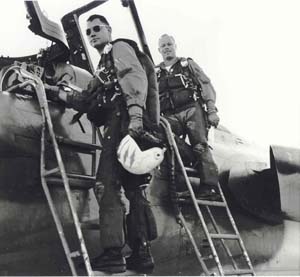 |
| Medal of Honor recipient Maj. Leo Thorsness (l) and his backseater, Capt. Harold Johnson, climb out of their aircraft after a Wild Weasel mission. |
The early concept of Wild Weasel hunter-killer teams searching out and destroying SAMs did not last long. The Weasels were too few in numbers and all of them were required to escort the strike forces. The regular practice was for a four-ship Weasel flight to accompany the fighter-bombers when they went north. Ideally, all four aircraft in the flight would have been full-up Weasels, but there were never enough of them for that. Typically, the element leaders—flying in the No. 1 and No. 3 positions—were F-105F Weasels with F-105Ds in the wing positions. Sometimes only the flight leader was a Weasel.
All Weasel missions were into high-threat areas because that’s where the SAMs were. The Weasels, using themselves as bait, went in several minutes ahead of the main strike force to clear a path through the SAMs. “In essence, we would go in high enough to let somebody shoot at us and low enough to go down and get them,” said Maj. Leo K. Thorsness, leader of the Weasels at Takhli. If the site operators turned on the tracking radar or fired a missile, the Weasels would attack.
Each SAM site had five or six launchers, situated in a six-pointed star pattern around a 40-foot ring. The missiles were guided by a Fan Song radar in a van in the center of the ring. It took only six hours for the North Vietnamese to pack up the entire site and have it operational in a different location.
The SAMs were not effective below 3,000 feet, so the North Vietnamese covered this zone with anti-aircraft artillery, which was particularly lethal at that range. When the Weasels eluded the SAMs by diving to lower altitudes, they entered the prime shooting gallery of the enemy guns.
The sites themselves were usually well camouflaged and difficult to see before the missile launched. However, when the Weasel aircraft was painted by the beam from the Fan Song, the crew got a distinctive crackle in their headsets. They called it the “rattlesnake.” The Fan Song needed about 75 seconds to acquire the target and fire the missile, which gave the Weasels time to home on the radar signal and shoot first.
Outwitting SAM
As employed against fighters in Vietnam, the SA-2 had a range of 17 miles, about twice the range of the Shrike, but Thorsness and his EWO, Capt. Harold E. “Harry” Johnson, found a solution. “We were consistently outgunned by 10 miles until Harry and I came up with the Shrike toss: Climb to 35,000 feet, plug in burner, pull nose up to 45 degrees—nearly stalled out,” Thorsness said. “We could hit SAMs about 35 miles away with this maneuver, a celebration day the first time we pulled it off.”
The next problem was to deal with the oncoming SAM. “The first stage booster that launches the SAM creates a good-sized dust storm on the ground, so if you happen to be looking in the right direction when it blasts off, you know that Sam is airborne and on the prowl,” said Col. Jack Broughton, vice wing commander at Takhli. “After the booster has done its job, it drops off and falls back to earth, leaving the propulsion to Sam’s internal rocket power. If you can see Sam, you can usually escape. It has little, stubby wings and it is going like hell, so it can’t turn very well. You can take it on just like another aircraft, and if you force it into a commit position and outturn it, it will stall out and auger in.”
At the warning cry of “Take it down!” the Weasels went into their most famous maneuver, the SAM break, a high-speed dive past the rising missile, followed by a sharp pull up and change of direction. “Sometimes by descending you can even lose the SAM radar tracking you, or force the SAM to overshoot and pass harmlessly by,” said Capt. Don Carson, a Weasel at Korat. “If this does not work, at least you have one heck of a lot of airspeed you can use to make a break at the last moment and maybe make the SAM miss your aircraft.”
Another tactic, developed by Capt. Jerry N. Hoblit at Takhli, was to split the four-ship flight into two pairs, one Weasel element on the left side ahead of the strike force and the other on the right. This allowed them to provide more coverage, although at increased risk to themselves.
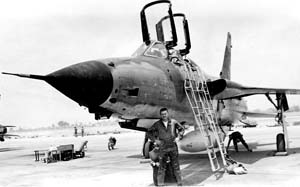 |
| Medal of Honor recipient Capt. Merlyn Dethlefsen, pictured with his “Thud” at Takhli AB, Thailand. |
Sometimes the SAM site operators fired their missiles in groups of three. “The North came up with a new tactic we called Dr. Pepper, and the Weasels wound up dodging missiles coming at them from 10, 2, and 4 o’clock at the same time,” Broughton said. (Dr. Pepper soda pop bottles of the day featured a dial with 10, 2, and 4 o’clock marked.)
The Weasels were not only first in but also last out. Their presence was often enough to intimidate the SAM operators and make them turn off their radars. To maintain the suppression, some of the Weasels remained as a rear guard until the last of the strike flight had departed.
Beginning in late 1967, the F-105Fs were upgraded to an F-105G configuration, which had improved avionics. In addition, they got a better weapon, the AGM-78 Standard anti-radiation missile, which not only was faster than the Shrike but also had almost four times its range and a larger warhead. From March 1968 on, the Standard ARM steadily supplanted the Shrike.
The Weasels were less enthusiastic about another innovation—electronic countermeasures jamming pods. The defensive advantages of an ECM pod were offset by the fact that the pod rendered the radar homing and warning gear useless. “Toward the end of our era there, I was given the option of carrying one Shrike and one ECM pod,” Thorsness said. “I had confidence in the evasion tactics we developed and not a lot of confidence in the ECM pod, so we always went with two Shrikes for more killing power.”
Weasel aircraft, already in short supply, were spread even thinner when some of the F-105Fs were modified for night and all-weather bombing under the Commando Nail program. Participants were also called “Ryan’s Raiders,” after the Pacific Air Forces commander, Gen. John D. Ryan, whose idea it was.
Some pilots flew both Wild Weasel and Commando Nail missions. Among those little impressed with the latter concept was Gen. William W. Momyer, commander of Seventh Air Force in Saigon, who would have preferred to use all of the F-105Fs to fight SAMs.
The Weasels, like other aircrews in Vietnam, were hampered by operational constraints. “Knowing that US rules of engagement prevented us from striking certain kinds of targets, the North Vietnamese placed their SAM sites within these protected zones whenever possible to give their SAMs immunity from attack,” said Momyer. “Within 10 miles of Hanoi, a densely populated area that was safe from attack except for specific targets from time to time, numerous SAM sites were located.”
“We could not, however, hit the SAMs that were unloaded and stacked in rows at Haiphong harbor,” Thorsness said. “Sometimes the Russian ship was still unloading, but we could not touch the ship or SAMs. Stupid war!”
The effectiveness of the North Vietnamese SAM operators, measured by the number of US aircraft shot down compared to the number of missiles fired, declined from 5.7 percent in 1965 to less than one percent in 1968. The toll was further reduced by the intimidation factor; some SAM crews would shut down their systems for fear of Wild Weasel attack. Unfortunately, US losses were still high, because the North Vietnamese launched more missiles with each passing year. The worst year was 1967, when 3,202 SAMs were fired, bringing down 56 American airplanes.
The epic battle between Weasels and SAMs tapered off in 1968 with the halt of US bombing of North Vietnam. When the fighter wing at Takhli was deactivated in 1970, most of the surviving Weasels pulled out of Southeast Asia, and those that remained were consolidated into a single squadron at Korat.
In January 1970, the Weasels began escorting RF-4C reconnaissance aircraft on flights over North Vietnam, but were tightly restricted in the circumstances under which they were allowed to fire on a SAM site. Under the “protective reaction” rules of engagement, a Weasel could not engage until the Fan Song radar was activated against it or an RF-4.
However, the North Vietnamese had upgraded their defenses. They tracked the US reconnaissance flights with long-range radars whose emissions the Weasels could not detect. The Fan Song, netted to these radars, could wait until the last minute to turn on. In one four-month period, some 200 SAMs were launched at US aircraft.
This set up a vast controversy in which Gen. John D. Lavelle, commander of Seventh Air Force, reasoned that the air defense system was thus activated whenever US fighters were present and that a protective reaction strike was justified. In 1972, it came to light that operations reports had been falsified to indicate that the RF-4s had been fired upon when, in actuality, the “preplanned protective reaction” strike was against targets developed by intelligence reports. Lavelle was summarily relieved from command, ordered back to the United States, and retired with a two-grade reduction in rank.
The Final Weasel Mission
The Lavelle imbroglio was still swirling in March 1972 when a large North Vietnamese force crossed the Demilitarized Zone in the “Easter Invasion.” Suddenly, the war—and the bombing of North Vietnam—was back on.
The resumed air campaign in North Vietnam was named Operation Linebacker, which evolved into Linebacker II. Most of the US ground forces had been withdrawn under President Nixon’s “Vietnamization” policy, so the Air Force and Navy launched an airpower buildup in response.
The Weasels at Korat were reinforced by a squadron from McConnell AFB, Kan., which raised to 28 the number of F-105Gs in theater and also brought in a new kind of Weasel: the F-4C. It had been understood from the beginning that the F-105 could not be the final answer to the Weasel requirement. The Thud production line was closed and replacements for those lost were limited. An F-4C Weasel variant had been developed at the same time as the F-105 Weasel, and squadrons were based in Germany and Okinawa, at Kadena Air Base. The Kadena squadron deployed to Korat in October 1972, but had to fly its missions north armed with Shrikes. There was not enough space on the airframe for the Standard ARM.
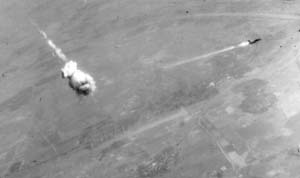 |
| An F-105 trails smoke just after a near interception by an SA-2 missile. The missile missed the aircraft, but the automatic fuse detonation threw fragments over a wide area. |
North Vietnam had about 30 SAM sites in operation, and during Linebacker, they fired 4,244 missiles at US aircraft. The Weasels teamed with F-4E fighter-bombers to wipe out SAM sites, radar vans, and launchers with cluster bombs and other munitions. The final mission of the Weasels in Vietnam was to escort the B-52s in the Linebacker II bombing of Hanoi in December 1972.
There were some F-105s left at the end of the war, but their day was over. All models of the Thud had taken terrible losses and those not shot down were wearing out. Forty-six Weasel F-105s and two Weasel F-100Fs were lost in combat.
The number of SAMs destroyed is uncertain. “A Soviet general who served with the North Vietnamese air defense forces claimed that they were provided with 98 missile systems and 7,500 missiles and finished the war with 45 sites and 2,300 missiles,” said Hoblit, who has collected a trove of data about the Weasels and the SAMs.
To the number, whatever it is, must be added the beneficial effect of suppressing and deterring the SAMs through intimidation. There is no way to figure how many US airmen lived through the war because of the efforts of the Wild Weasels.
The next-generation Weasel was the F-4G, introduced in 1978. It was a modified version of the F-4E, larger than the F-4C, and it could employ either the Standard ARM or the new AGM-88 HARM.
The F-4G remained in service for 20 years, and performed with distinction in the Gulf War.
The Wild Weasel mission today is performed by specially trained F-16CJ crews, carrying on the tradition established by the F-100s and F-105s in combat over North Vietnam.
Weasels of NoteTwo Weasel pilots from the Vietnam War were awarded the Medal of Honor: Capt. Merlyn H. Dethlefsen. On March 10, 1967, Dethlefsen was leading the second element of the Weasel flight from Takhli, escorting a large strike force against the Thai Nguyen iron and steel works north of Hanoi in North Vietnam. When the flight leader went down, Dethlefsen took over. His aircraft was hit numerous times and sustained severe damage, but he made five passes against the air defenses, suppressed the SAMs, and destroyed at least one SAM site. He remained in the target area for an incredible 10 minutes in the face of an intense flak barrage. Maj. Leo K. Thorsness. On April 19, 1967, Thorsness was leading the Wild Weasel flight from Takhli, escorting a strike force bound for the North Vietnamese military complex at Xuan Mai in the Red River delta. Thorsness and his EWO, Capt. Harold E. Johnson, were credited with taking on “most of North Vietnam,” including MiGs, SAMs, and air defense guns. They shot down a MiG-17 and probably got another MiG, unconfirmed, because the gun camera had run out of film. When they had expended their Shrikes and cluster bombs, they refueled and returned to the area to fly cover for rescue teams, armed only with their 20 mm cannon. Thorsness received the Medal of Honor and Johnson was awarded the Air Force Cross. Eleven days later, on their 93rd mission, they were shot down and spent the rest of the war as POWs. Fifteen Weasels were awarded the Air Force Cross for action in Southeast Asia: Maj. Robert S. Beale; Lt. Col. Earl G. Cobeil; Capt. John A. Dramesi; Capt. Kevin A. Gilroy; Maj. Gerald C. Gustafson; Capt. Jerry N. Hoblit; Capt. Harold E. Johnson; Lt. Col. James E. McInerney Jr.; Maj. Paul J. Mongillo; Maj. William P. Robinson; Capt. Fred Shannon; Capt. Rowland F. Smith Jr.; Maj. Bruce D. Stocks; Maj. Peter Tsouprake; and Capt. David H. Williams. Two Weasels from the Vietnam War went on to become Air Force four-star generals. Chuck Horner, air boss in the Gulf War, was a Weasel at Korat in 1967. Joe Ralston, later vice chairman of the Joint Chiefs of Staff and NATO’s supreme allied commander in Europe, was a Weasel at Takhli in 1970. |
John T. Correll was editor in chief of Air Force Magazine for 18 years and is now a contributing editor. He wrote two previous articles on Wild Weasels for Air Force Magazine, “Full Day,” about Leo Thorsness (June 2005), and “Calculated Courage at Thai Nguyen,” about Merlyn Dethlefsen (February 2006).
